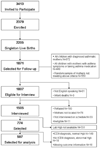Association of maternal anemia with increased wheeze and asthma in children
- PMID: 21277514
- PMCID: PMC3073499
- DOI: 10.1016/j.anai.2010.11.007
Association of maternal anemia with increased wheeze and asthma in children
Abstract
Background: Increasing interest has focused on maternal nutrition and micronutrient status during pregnancy and respiratory disease development in the offspring.
Objective: To examine the relationship between maternal anemia in pregnancy with wheeze and asthma in early childhood.
Methods: The cohort included children of women followed through pregnancy and recontacted when the child was 6 years of age to evaluate respiratory health. Exposure was assessed using maternal anemia diagnosis and hemoglobin (Hgb) < 11 during delivery hospitalization. Study outcomes include wheezing in early childhood; patterns of wheeze from birth to age 6 (early-onset transient wheeze; late-onset wheeze; early-onset persistent wheeze); and diagnosis of childhood asthma.
Results: Maternal anemia was reported by 11.9% of mothers and was associated with recurrent infant wheeze in the first year (adjusted odds ratio [ORa] = 2.17, 95% confidence interval [CI] 1.18, 4.00), wheezing before age 3 (Ora = 2.42, 95% CI 1.38, 4.23), and early-onset transient and early-onset persistent wheeze patterns (Ora = 2.81, 95%CI 1.38, 5.72, and Ora = 2.07, 95% CI 1.02, 4.22), respectively. Among children of mothers with asthma, maternal anemia was associated with recurrent wheeze in year 1 (Ora = 4.22, 95% CI 1.65, 10.80) and wheeze before age 3 (Ora = 2.73, 95% CI 1.17, 6.35). Offspring of mothers with asthma also had increased odds of asthma diagnosis (Ora = 2.53, 95% CI 1.04, 6.17) and current asthma (Ora = 3.46, 95% CI 1.45, 8.26).
Conclusions: Maternal anemia during pregnancy is associated with infant respiratory health outcomes. If this observation is replicated, maternal anemia may be a target for intervention and future research.
Copyright © 2011 American College of Allergy, Asthma & Immunology. Published by Elsevier Inc. All rights reserved.
Conflict of interest statement
Similar articles
-
Impact of parental asthma, prenatal maternal asthma control, and vitamin D status on risk of asthma and recurrent wheeze in 3-year-old children.Clin Exp Allergy. 2019 Apr;49(4):419-429. doi: 10.1111/cea.13320. Epub 2019 Jan 3. Clin Exp Allergy. 2019. PMID: 30461089 Free PMC article.
-
Preconceptional exposure to oral contraceptive pills and the risk of wheeze, asthma and rhinitis in children.Allergol Int. 2016 Jul;65(3):327-31. doi: 10.1016/j.alit.2016.02.012. Epub 2016 Mar 30. Allergol Int. 2016. PMID: 27038776
-
Wheeze trajectories are modifiable through early-life intervention and predict asthma in adolescence.Pediatr Allergy Immunol. 2018 Sep;29(6):612-621. doi: 10.1111/pai.12922. Epub 2018 Jun 19. Pediatr Allergy Immunol. 2018. PMID: 29729041
-
Epidemiology of asthma and recurrent wheeze in childhood.Clin Rev Allergy Immunol. 2002 Feb;22(1):33-44. doi: 10.1007/s12016-002-0004-z. Clin Rev Allergy Immunol. 2002. PMID: 11803801 Review.
-
Maternal vitamin D intake during pregnancy and risk of asthma and wheeze in children: a systematic review and meta-analysis of observational studies.J Matern Fetal Neonatal Med. 2021 Feb;34(4):653-659. doi: 10.1080/14767058.2019.1611771. Epub 2019 May 7. J Matern Fetal Neonatal Med. 2021. PMID: 31018731
Cited by
-
Iron-Deficiency in Atopic Diseases: Innate Immune Priming by Allergens and Siderophores.Front Allergy. 2022 May 10;3:859922. doi: 10.3389/falgy.2022.859922. eCollection 2022. Front Allergy. 2022. PMID: 35769558 Free PMC article. Review.
-
Investigating the Links between Lower Iron Status in Pregnancy and Respiratory Disease in Offspring Using Murine Models.Nutrients. 2021 Dec 14;13(12):4461. doi: 10.3390/nu13124461. Nutrients. 2021. PMID: 34960012 Free PMC article.
-
Advances in respiratory physiology in mouse models of experimental asthma.Front Physiol. 2023 Mar 16;14:1099719. doi: 10.3389/fphys.2023.1099719. eCollection 2023. Front Physiol. 2023. PMID: 37008013 Free PMC article. Review.
-
Association of Hemoglobin and Hematocrit Levels during Pregnancy and Maternal Dietary Iron Intake with Allergic Diseases in Children: The Japan Environment and Children's Study (JECS).Nutrients. 2021 Mar 1;13(3):810. doi: 10.3390/nu13030810. Nutrients. 2021. PMID: 33804474 Free PMC article.
-
Associations between maternal complications during pregnancy and childhood asthma: a retrospective cohort study.ERJ Open Res. 2023 Apr 11;9(2):00548-2022. doi: 10.1183/23120541.00548-2022. eCollection 2023 Mar. ERJ Open Res. 2023. PMID: 37057092 Free PMC article.
References
-
- Akinbami LJ, Moorman JE, Garbe PL, Sondik EJ. Status of childhood asthma in the United States, 1980–2007. Pediatrics. 2009;123 Suppl 3:S131–S145. - PubMed
-
- Bloom B, Cohen RA, Freeman G. Summary health statistics for U.S. children: National Health Interview Survey, 2007. Vital Health Stat 10. 2009;(239):1–80. - PubMed
-
- Devereux G. Early life events in asthma - diet. Pediatric Pulmonology. 2007;42:663–673. - PubMed
-
- Burri PH. Structural aspects of prenatal and postnatal development and growth of the lung. In: McDonald JA, editor. Lung Growth and Development. New York: Marcel Dekker, Inc.; 1997.


